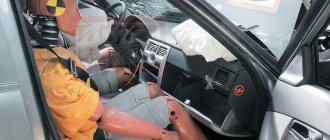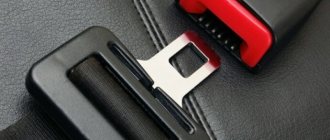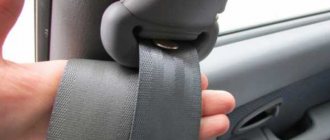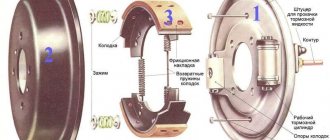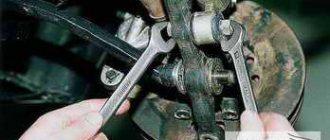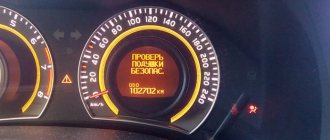Print this article Font size 16
Every car, regardless of manufacturer and configuration, must be equipped with seat belts. This is an international requirement, the violation of which entails very serious consequences. Moreover, both for the manufacturer and for the owners of such cars.
As you understand, the VAZ 2110 is no exception, and therefore the design of its interior includes seat belts.
Device type
FAQ
Question: Where are the tapes sold?
Answer: In an online store. You can even use AliExpress. As a rule, the tapes from there are very durable, but they may look worse than those from official stores. One meter of a good colored belt will cost about 350 rubles.
Question: Is there a difference between goods from online stores and specialized centers?
Answer: In fact, there is no difference, but here is the case when it is better to trust official stores. Even if the chance that online stores will send you something of poor quality is small, but if possible, it is better to contact a specialized center.
Question: Should I replace it on a regular basis? Like oil, for example.
Answer: Of course, you need to check your seat belts, but not to the point of fanaticism. Have it inspected every few years, and if there are problems, try to fix them.
The main causes of failure of inertial belts
Among the common breakdowns that occur during the operation of seat belts and the mechanisms that control their operation are the following:
- jamming of the belt when trying to fasten, even if pulled out smoothly;
- belts do not stretch due to frost or wear of the roller mechanism;
- the straps do not retract when unfastened;
- The spool lock is broken or the main mechanism is damaged.
Of course, there are other problems, but they are less common, which means that the risk of encountering such a breakdown in your car is minimal. Many people believe that in case of some breakdowns it is possible to drive with faulty seat belts, but, according to traffic rules, if a vehicle is operated with a faulty seat belt mechanism, an administrative fine may be imposed on the driver.
Faulty seat belt mechanism
In addition, the car manufacturer is not responsible for a traffic accident, even if the car is under warranty if the owner does not contact specialists to replace the seat belts. Therefore, before you repair belts with your own hands, you need to understand that all changes are made, as they say, at your own peril and risk.
Most often, owners decide to do their own repairs due to the very expensive maintenance. For example, replacing a belt mechanism or completely replacing belts on a standard middle-class passenger car will cost the owner at least 15 thousand rubles. Not everyone is ready to pay that kind of money, especially if it is a simple breakdown, for example, the need to lubricate or replace the gear of the main mechanism.
Features of penalties
If a traffic police officer finds an unbelted passenger in the car, he will issue a double fine. The driver will also suffer the same fate and will be fined RUB 1,000. Why, you ask, since the motorist is not to blame? In fact, law enforcement officials do not think so.
According to the law, it is the responsibility of the car owner (driver) to monitor the condition of the car, including its internal systems, and timely replacement of the seat belt. The driver can make payment within 20 days, in which case the fine will also cost him 500 rubles
Particular attention should be paid to small passengers and restraints for their safe trip.
How to remove front seat belts
First, unscrew the two bolts located at the bottom of the plastic box.
Then use a flat screwdriver to pry up and remove the plug. Underneath there is a bolt that needs to be unscrewed.
There is one more bolt left on top of the plastic box, which also needs to be unscrewed. Next, unscrew the top fastening.
Now you need to open the plastic window on the box and pull out the textile element along with the coil.
To remove belts on a foreign car, for example a BMW, you first need to remove the plastic covers. They are attached using four clips, two of which are attached at the bottom. The other two are fixed on top.
The fastening elements are unscrewed using a TORX key.
Then you need to unscrew the bolts of the fixing metal part. In this case, only one bolt can be unscrewed.
The plastic cover is removed using a special tool. You can also pry out the plastic with a regular screwdriver. There will be quite a lot of dust inside.
Now all that remains is to unscrew the bottom bolt.
After unscrewing the bolt, the belt should come out easily.
To wash the belt, the removed mechanism must be disassembled. Next, installation is performed in reverse order.
Useful videos on the topic:
How to remove the front seat belts on a Volkswagen Polo
How to remove the front seat belts on a Toyota Camry
How to remove the seat belt on a VAZ 2110, 2111, 2112
We will tell you step by step how to remove the belt on VAZ models.
First you need to use a screwdriver to pry and remove the decorative trims of the lower and upper seat belt fastenings.
There will be bolts under the covers that need to be unscrewed with a 17mm wrench.
Next, remove the upper belt fastening bracket.
Next, you will need to remove the plastic cover to free the coil. To do this, you need to unscrew several screws on it:
- two on the lower pillar, near the sills;
- one - in the central part of the pillar, near the seat belt guide;
- and another one at the top of the counter.
The cover is removed.
Next, you need to remove the coil - it is located at the bottom of the rack. To do this, use a 17mm wrench to unscrew the bolt holding it in place. Afterwards the coil is simply removed.
All is ready!
How to pull a seat belt out of a reel
When all the bolts are unscrewed, you need to correctly pull the belt. To do this, you need to pull it while holding the coil with your finger. To pull out the end with the stopper, you need to pull harder.
Now you need to carefully pull the strap out of the reel, holding it.
Pulling the seat belt from the reel
In this case, you need to make sure that the spring does not unwind. To do this, place a screwdriver inside the mechanism instead of a stopper.
This is very important, since an unwound spring is difficult to put back in place manually.
Reel stopper
How to remove a jammed belt
If during disassembly you cannot pull out the strap, then the reason is that the mechanism is jammed. In this case, it is impossible to pull it out; the belt gets stuck and does not move. To solve the problem, it is enough to use the tools that most car enthusiasts have in their garage.
First, you will need to unscrew the screws on the lower trim of the middle door pillar (if there are no screws on the trim, it may simply be held on by brackets/clips). After this you need to remove the cover. To do this, just lift it and pull it towards you. Next, you need to pull out the belt and lock the mechanism.
Removing the center pillar trim
The next step is to unscrew the bolt that holds the coil in place. Once unscrewed, it can be easily removed.
To prevent accidental winding, the strap is secured with a paper clip. The coil must be shaken, the mechanism must shake
It is important to remember where it is. Using a thin wire, it is important to squeeze out the plastic caps
When removing, the pistons must be held, as they may fall and get lost.
Now you can use a slotted screwdriver to pry and remove the cover located on the mechanism side. Under the lid there should be a plastic box with a cylinder, in the middle of which there is a metal ball. The rocker arm of the locking mechanism will also be attached here. The box needs to be hooked with wire and pulled out.
Disassembled seat belt reel
Next comes the check
It is important to check the rocker arm, which should rotate freely on the axle. If this unit jams, then the axle needs to be washed and the clogged dust removed
After checking the primary mechanism, you need to inspect the main one. It is also under the cover. This unit, made of metal, is located under the plastic gear. You can remove the gear from its recess without using tools. In the middle of the connector there should be a toothed ex class=”aligncenter” width=”640″ height=”480″[/img]
Then remove the paper clip from the belt, while holding it to prevent it from unwinding. The connector of the main mechanism must be cleaned of contaminants, which often cause jamming. To do this, first carefully pour gasoline over it. You need to take the reel while holding the guide. At this time, wind the belt with your right hand, while trying to tighten it.
It is necessary to make several sharp jerks for the mechanism to lock. After the manipulations have been completed, the belt is again installed on the reel. And again you need to wind it several times, while simultaneously tightening it. The performed operations should solve the jamming problem.
More details and more clearly about this process in the video:
Possible problems when removing the belt and after it
It happens that the driver pulls out the belt, but it does not tighten at all. Most likely, the reason is not at all due to incorrect installation of the node. Most often, this problem is caused by a breakage of the spring inside the drum. It is a consumable item and can be easily replaced.
The opposite situation also occurs when the strap jams and does not extend. This means that the internal mechanism lock has broken. Such cases often occur after an accident. Then you need to follow the instructions above, which indicate what to do if it jams.
If the spring unwinds during removal, it will be difficult to wind it back. But it is not necessary to immediately change it to a new one. The coiled spring must be wound in the direction in which its short part is directed.
Spring in coil
Design and types of seat belts
These devices differ in the number of attachment points. There are modifications from two-point to six-point. Two-point ones are found in older cars; they are attached to the waist on both sides of the seat. Modern cars use three-point belts that evenly distribute the energy of a moving body. Other types are installed on sports cars. Five-point ones are also attached to child car seats.
The design of a modern three-point belt consists of the following elements:
- The strap is made of durable material - it is attached not to the seat, as in sports cars, but to the body. A metal tip is attached to the end; the person locks it before the trip. It has three attachment points - on the threshold, rack and rod. Most models provide the ability to adjust the belt depending on the height of the passenger.
- Retractor reel - allows you to unwind the belt. It is designed in such a way that it is blocked during a sharp jerk. Therefore, in the event of an accident, the belt does not unwind.
- Lock - necessary to secure the belt. It usually sends a signal to the dashboard to remind the driver to buckle up.
- Tensioner is a device that includes shock sensors. When there is a strong impact, they send a signal to the control unit, which activates the tensioners. To ensure that when the freedom of fit decreases, the belt does not exert excessive pressure on the person, a limiter is installed.
Safety belt
If one of the mechanism components malfunctions, it is necessary to repair the breakdown as soon as possible. But repairs can only be made after removing the seat belt. Motorists often have to disassemble this element. This is due to the fact that, like other parts of the interior, it becomes dirty over time. To wash a belt, you must first remove it, and do it correctly.
Design and operating principle
The design of the protective device in question is represented by a retractor reel, a lock and a tape. High-strength material is used to make the tape; this element is fixed to the body in several zones as follows:
- in the area of special traction with a lock;
- on the counter;
- in the threshold area.
The main purpose of the lock, in turn, is to lock the belt. This element is located near the seat. A movable tongue made of durable metal simplifies the operation of the belt; it is located directly on the belt. You can find a retractor coil on the car body pillar. Its purpose is to forcefully wind and unwind the tape. The design of the retractor reel provides for the presence of an inertial locking mechanism, due to which, in the event of a sudden stop, the movement of the belt is stopped and the person remains in a fixed position, not being able to go into free flight through the windshield.
The principle of operation is nothing complicated: the action of a coil with a blocker is based on a gear mechanism that rotates it. The closing of this mechanism occurs through a pendulum; it can have a ball or spheroid support with a lever system.
Smooth unwinding of the tape promotes rotation of the support along with the reel gear, while sudden tension leads to blocking of the flywheel.
Repair options
Troubleshooting measures directly depend on the cause of the breakdown:
- If you have successfully pulled out the belt, buckled it, but when you need to unfasten the belt does not return to its original position, the problem may lie in the spring. It often comes off due to prolonged use or under stress. It is necessary to disassemble the lining and reach the drum to install the spring in the correct position. If it is still there, you will have to change the drum.
- Dirt on the belt and in its fixation areas can also cause the belt to not return to its original position. This problem is most common with older cars. Just rinse the entire device and dry it thoroughly.
- If the device is jammed and the seat belt does not extend at all, the cause may also be the accumulation of dirt, but not on the belt, but directly in the mechanism. To fix the problem, use a special composition, which can be purchased at any auto supply store. Spray it as close to the mechanism as possible and try moving the tape a couple of times to develop the device. You can also disassemble the device yourself and clean it, but first pull out the tape to the end and secure it with improvised devices, which can be a clothespin or a paper clip.
Design and operating principle
The design of the protective device in question is represented by a retractor reel, a lock and a tape. High-strength material is used to make the tape; this element is fixed to the body in several zones as follows:
- in the area of special traction with a lock;
- on the counter;
- in the threshold area.
The main purpose of the lock, in turn, is to lock the belt. This element is located near the seat. A movable tongue made of durable metal simplifies the operation of the belt; it is located directly on the belt. You can find a retractor coil on the car body pillar. Its purpose is to forcefully wind and unwind the tape. The design of the retractor reel provides for the presence of an inertial locking mechanism, due to which, in the event of a sudden stop, the movement of the belt is stopped and the person remains in a fixed position, not being able to go into free flight through the windshield.
The principle of operation is nothing complicated: the action of a coil with a blocker is based on a gear mechanism that rotates it. The closing of this mechanism occurs through a pendulum; it can have a ball or spheroid support with a lever system.
Smooth unwinding of the tape promotes rotation of the support along with the reel gear, while sudden tension leads to blocking of the flywheel.
Troubleshooting seat belt problems
At the very beginning, it is worth making a reservation that driving with a malfunctioning safety device is not only costly (after all, valiant traffic inspectors are not asleep and will happily issue you a fine for such an offense), but most importantly, it is life-threatening.
Of course, if the seat belt breaks, you can contact a specialized service station, where specialists will quickly and efficiently carry out repair work. However, you can do this yourself, and with the help of our tips it will be completely easy and simple.
There are a large number of belt malfunctions; we will focus on the most common problems and try to eliminate them. It often happens that the belt does not want to screw back in.
Sound familiar? They got into the car, buckled up, drove to their destination, unfastened the belt, and it remained unassembled. The situation, admittedly, is unpleasant, but, fortunately, not hopeless. Usually the cause of such a breakdown is a failed drum; to replace it, you need to remove the casing. However, often to restore the drum's functionality it is enough to replace the spring, which often simply flies out due to strong tension. Agree, everything is much simpler than one might expect
Just don’t relax too much and take precautions while working, otherwise you risk injuring your hands, in which case the seat belt, no matter how paradoxical it may sound, becomes dangerous
It often happens that the belt does not want to screw back on. Sound familiar? They got into the car, buckled up, drove to their destination, unfastened the belt, and it remained unassembled. The situation, admittedly, is unpleasant, but, fortunately, not hopeless. Usually the cause of such a breakdown is a failed drum; to replace it, you need to remove the casing. However, often to restore the drum's functionality it is enough to replace the spring, which often simply flies out due to strong tension. Agree, everything is much simpler than one might expect
Just don’t relax too much and take precautions while working, otherwise you risk injuring your hands, in which case the seat belt, no matter how paradoxical it may sound, becomes dangerous
It happens that the belt begins to jam. To do this, it is also necessary to remove the trim and check the serviceability of the mechanism that drives the belt. Usually it is enough just to clean it of dirt, after which it returns to its former performance. However, simply pulling out and cleaning the mechanism, as is done in most cases, is too labor-intensive and quite time-consuming, so it is better to take a can of special dye, inject it several times into the mechanism and pull the belt back and forth a couple of times, in this simple way the heads of the mechanism will be cleaned and the belt will stop jamming.
Do-it-yourself seat belt reel repair
Regardless of the car model, in order to get to the mechanisms that are responsible for the proper operation of the seat belts, it is necessary to remove the plastic lining of the side panel. On almost all models it is held either with clips at the top and bottom or with bolts of various diameters. To access the trim, you need to move the seat as far forward as possible, or remove it according to the instructions (unscrew several front and rear fastening bolts and remove the seat from the slide).
To comply with safety precautions, especially for cars with side airbags, before starting work with the belt reel, it is necessary to remove the negative terminal from the battery and, if possible, the contacts on the airbags (can be seen by the color of the wires in the car’s electrical circuit). This must be done to prevent the squib from firing, which could lead to injury. The reel, as a rule, is closed with a plastic case with the inscription “Do not open”, but in order to eliminate the cause of the breakdown, it still needs to be opened. This plastic casing is attached to the rack with several bolts.
Removing the negative terminal from the battery
If the seat belt does not retract well, then the return mechanism spring may simply have fallen off or been damaged. If the problem is the spring, it can be replaced. At the replacement stage, you should be careful, since removing the spring mechanism is easy, but installing it back on the reel is quite problematic. There is no specific installation scheme; it all depends on the model and complexity of the mechanism.
Another common reason why the belt does not retract back is wear of the metal tensioner tape or a break in the steel angle that threads the tape into the hole on the shaft. Because of this break, the shaft spins idle, that is, it does not wind the tape around itself. If the corner is not severely torn, you can bend the tape with pliers and correct its position by bending the tip a little closer than intended.
As you can see, repairing a belt is not difficult, but the process can be lengthy. Buying a new seat belt will save you a lot of time if you're running short. Before purchasing, make sure that the selected seat belts match the make of your car.
Sequence
the front seats are moved forward as much as possible, the seat backs are also tilted forward and access to the coil mount is opened; the coil is dismantled; the belt is fully extended and the side of the blocker placement is determined by the presence of a plastic square; Important: an error with the determination will lead to disassembly of the coil from the spring side, which can severely cut your face and hands! by pulling out the four pistons, the housing cover is removed in a horizontal position; the coil is disassembled and access to the ratchet is opened; old thickened grease is removed from all moving parts; The reel mechanism is filled with frost-resistant lubricant, for example,
What will be required for repairs?
For the reasons mentioned above, sometimes the seat belt does not extend. What to do? Advice from experienced auto mechanics will help. First of all, you will have to disassemble the casing and remove the coil. In some models, you will have to dismantle the seats in the place where the breakdown occurred.
To do this, you need to prepare screwdrivers (flat and Phillips), as well as spanners. Their diameter should be different. You should also purchase a multi-purpose lubricant. The seats must be protected from accidental contact with oil. You will also need napkins and wire.
Repairs can be simple or more complex. In some cases, you have to completely change the coil. For some machine models, you will need to prepare special tools. But repairing a seat belt yourself will help save quite a lot of money in the family budget.
In what cases is replacement required?
Let's consider two reasons:
- Practical. For a huge number of reasons, a seat belt fails. And we are talking not only about the seat belt webbing, but also about the main mechanism for holding the belt tongue. This can happen due to mechanical stress on the belts, which may be exerted on them due to the car being involved in an accident or due to other reasons caused by the owner. Or due to banal wear and tear of both the mechanism itself and the tape. Time can destroy any mechanism, even a strong one.
- Aesthetic. Over time, the seat belt webbing loses its beauty and aesthetic appeal. The appearance of worn areas and wear of the fabric to the point that the belt can break at any time. And a banal sense of beauty. Even a beautiful car interior can be ruined by seat belts worn to holes, with pieces of thread sticking out in all directions.
How do they work
Before starting repairs, it is important to understand exactly how seat belts work, what are their features, and what devices generally take part in protecting the driver and passengers.
- The coil lock is made on the basis of a ratchet mechanism, which is locked by a sensitive element. Its role is played by a pendulum with a semi-spherical support. In some cases, this is a ball of metal placed in a sphere with a large diameter.
- The pendulum or ball moves, while the ratcheting gear of the reel is fixed to the body through a system of levers.
- A flywheel disc is located on the gear axis on screw splines.
- When the straps are slowly tightened, the disc rotates with the shaft due to friction, but does not lock the reel.
- If you make a jerk, the disk will put more pressure on the screw surface, acting by inertia, overcome the friction force and block the ratchet, moving along the screw splines.


